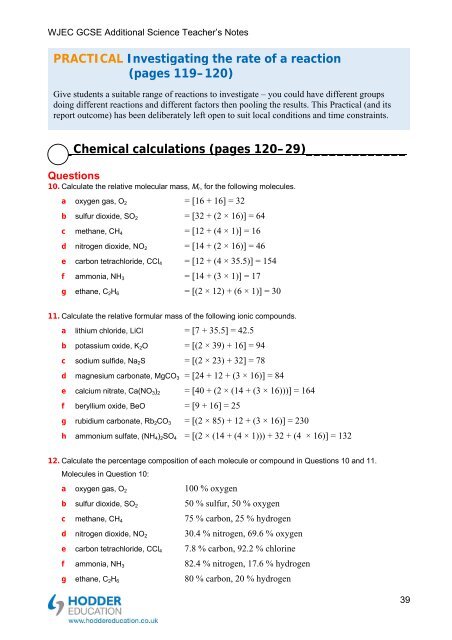Teacher's notes and answers to questions in the book - Hodder Plus ...
Teacher's notes and answers to questions in the book - Hodder Plus ...
Teacher's notes and answers to questions in the book - Hodder Plus ...
Create successful ePaper yourself
Turn your PDF publications into a flip-book with our unique Google optimized e-Paper software.
WJEC GCSE Additional Science Teacher’s Notes<br />
PRACTICAL Investigat<strong>in</strong>g <strong>the</strong> rate of a reaction<br />
(pages 119–120)<br />
Give students a suitable range of reactions <strong>to</strong> <strong>in</strong>vestigate – you could have different groups<br />
do<strong>in</strong>g different reactions <strong>and</strong> different fac<strong>to</strong>rs <strong>the</strong>n pool<strong>in</strong>g <strong>the</strong> results. This Practical (<strong>and</strong> its<br />
report outcome) has been deliberately left open <strong>to</strong> suit local conditions <strong>and</strong> time constra<strong>in</strong>ts.<br />
_Chemical calculations (pages 120–29)_____________<br />
Questions<br />
10. Calculate <strong>the</strong> relative molecular mass, M r , for <strong>the</strong> follow<strong>in</strong>g molecules.<br />
a oxygen gas, O 2 = [16 + 16] = 32<br />
b sulfur dioxide, SO 2 = [32 + (2 × 16)] = 64<br />
c methane, CH 4 = [12 + (4 × 1)] = 16<br />
d nitrogen dioxide, NO 2 = [14 + (2 × 16)] = 46<br />
e carbon tetrachloride, CCl 4 = [12 + (4 × 35.5)] = 154<br />
f ammonia, NH 3 = [14 + (3 × 1)] = 17<br />
g ethane, C 2 H 6 = [(2 × 12) + (6 × 1)] = 30<br />
11. Calculate <strong>the</strong> relative formular mass of <strong>the</strong> follow<strong>in</strong>g ionic compounds.<br />
a lithium chloride, LiCl = [7 + 35.5] = 42.5<br />
b potassium oxide, K 2 O = [(2 × 39) + 16] = 94<br />
c sodium sulfide, Na 2 S = [(2 × 23) + 32] = 78<br />
d magnesium carbonate, MgCO 3 = [24 + 12 + (3 × 16)] = 84<br />
e calcium nitrate, Ca(NO 3 ) 2 = [40 + (2 × (14 + (3 × 16)))] = 164<br />
f beryllium oxide, BeO = [9 + 16] = 25<br />
g rubidium carbonate, Rb 2 CO 3 = [(2 × 85) + 12 + (3 × 16)] = 230<br />
h ammonium sulfate, (NH 4 ) 2 SO 4 = [(2 × (14 + (4 × 1))) + 32 + (4 × 16)] = 132<br />
12. Calculate <strong>the</strong> percentage composition of each molecule or compound <strong>in</strong> Questions 10 <strong>and</strong> 11.<br />
Molecules <strong>in</strong> Question 10:<br />
a oxygen gas, O 2<br />
100 % oxygen<br />
b sulfur dioxide, SO 2<br />
50 % sulfur, 50 % oxygen<br />
c methane, CH 4 75 % carbon, 25 % hydrogen<br />
d nitrogen dioxide, NO 2 30.4 % nitrogen, 69.6 % oxygen<br />
e carbon tetrachloride, CCl 4 7.8 % carbon, 92.2 % chlor<strong>in</strong>e<br />
f ammonia, NH 3 82.4 % nitrogen, 17.6 % hydrogen<br />
g ethane, C 2 H 6<br />
80 % carbon, 20 % hydrogen<br />
39

















